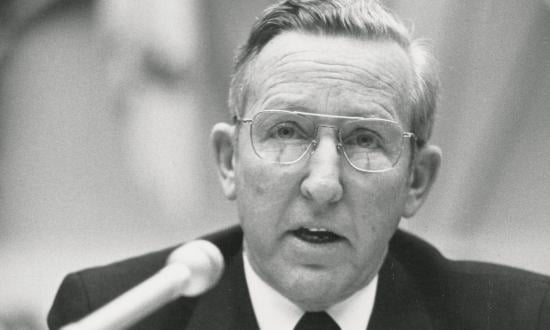While serving in the USS Saratoga (CV-60) in the late 1970s, I received a telegram from the American Red Cross conveying the sad news that my wife’s father had passed away. I was literally only a few miles away from Debby—we lived on base at Mayport, Florida, and the Sara was operating just off the coast—but it might as well have been 20,000 leagues in that moment of personal tragedy.
As it happened, we were about to commence an operational readiness inspection that was important in terms of fleet readiness—and to the Sara’s captain, Robert F. Dunn. He was an “up-and-comer” in the Navy, assigned to the Saratoga because she had been having considerable troubles (especially with her engineering plant), and the Navy hoped Bob Dunn was the one to turn her around. It seemed pretty clear that this inspection could make or break his career, and, like everything we did under Captain Dunn’s command, we had been preparing for weeks to get it right. I was the general quarters officer of the deck—a role that was at times pivotal—and, like the rest of the crew, I had spent much time and effort preparing.
Not to overestimate my own importance, I think it is fair to say that Captain Dunn would have preferred not to lose his trained GQ OOD the day before the inspection was to begin—in fact, I think it might even be fair to say that many commanding officers would have forbidden it. But not this CO.
Among his many attributes, Bob Dunn was extraordinarily attuned to his crew, and he fervently believed in loyalty up and down the chain of command, striking the right balance between demand and reciprocation. I was frequently amazed when he would know the names of the radiomen strikers who brought messages to him on the bridge—often asking such things as how the young sailor’s mother was faring with a recent malady. He knew that Debby was very close to her father and would be devastated by the unexpected news of his passing.
So I should not have been surprised when he told me that, in this case, my priority was with Debby, not the Sara. But I was very much surprised when he also told the air boss to get me off the ship by helo at first light so that I could join Debby in time to fly to Baltimore with her. This was leadership of the finest kind, and she and I never forgot it.
The inspection went well, and Captain Dunn continued his impressive career, eventually reaching the exalted rank of vice admiral and retiring as the Navy’s top aviator, Deputy Chief of Naval Operations for Air Warfare. Between that final assignment and his years at the U.S. Naval Academy with the class of 1951, he faced and prevailed over many more challenges.
After a Korean War tour in the USS Nicholas (DDE-449), he earned his wings in 1953 and began a long career in the sky, flying the AD Skyraider, A-4 Skyhawk, F-4 Phantom, and various other aircraft, including helicopters. His 9,000 hours of flying time included 934 carrier landings and 255 combat missions over Vietnam, in which he earned two Silver Stars, two Distinguished Flying Crosses, and a host of other awards. The last member of his class to retire, he flew his last mission in an F/A-18 Hornet on his 60th birthday.
His many assignments included commands of an air wing, a carrier group, the Naval Safety Center, and the Naval Air Force, Atlantic Fleet. All these remarkable achievements and those others too numerous to mention combine to portray an exemplary naval career that has earned Robert F. Dunn mountains of respect and admiration. While I include myself in that estimation, I cannot help but remember that special moment when then-Captain Dunn put the needs of a grieving spouse over his own and showed the kind of selfless leadership that I tried to emulate in the rest of my time in the Navy.









